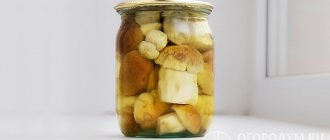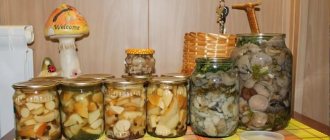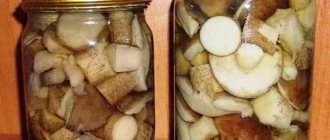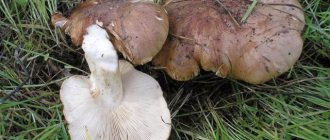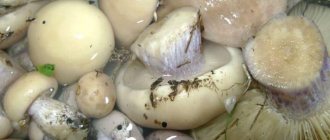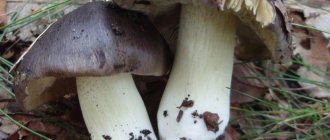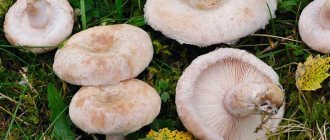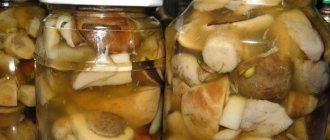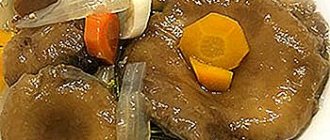Podtopolniki are little-known mushrooms, so only experienced mushroom pickers know about them. They are common in Siberia. From the name it is clear that they grow in close proximity to the poplar. Mushrooms have a fleshy cap and legs, have a high nutritional value, and therefore satisfy you for a long time.
Some housewives make blanks from poplar rows. Before cooking, they must be soaked, as they absorb harmful environmental substances. Picking mushrooms near the road is not recommended, as they can cause eating disorders and even poisoning.
In previous articles you could familiarize yourself with recipes for preparing honey mushrooms for the winter. Now let's look at recipes for salting and pickling poplar rows.
So, if you have collected mushrooms, then familiarize yourself with the methods of preparing them.
Pickled podtopolniki for the winter. How to pickle mushrooms for the winter
First of all, let's look at the recipe for pickling poplar row.
Important! Before cooking, mushrooms must be peeled, washed, and then soaked for several days, periodically changing the water.
For 1 liter of marinade we will need the following ingredients:
- 1 tbsp white sugar.
- 2 tbsp table salt.
- 60 ml table vinegar.
- Spices according to preference (peppercorns, cloves, garlic, dill umbrellas, bay leaf).
Pickling process
It is assumed that you have already prepared the floodplains, that is, soaked them for 2-3 days. Large mushrooms need to be chopped. Then they need to be placed in an enamel pan, filled with cold water and placed on the stove. Bring to a boil, skim off the foam and remove from the stove. As a result of cooking, the volume of mushrooms should decrease by 2-3 times. Remove the row using a slotted spoon and place in a separate container.
To prepare the marinade, add sugar, two heaped tablespoons of salt and spices to a saucepan with water. Boil. After that, add the mushrooms to the marinade and cook for 20 minutes. 5 minutes before cooking, add vinegar and chopped garlic.
After this, place the mushrooms in sterilized jars up to the shoulders, fill to the top with marinade, and roll up the lids with a special machine.
Place the workpiece upside down in a dark place and cover with a towel. When it cools down, put it in the cellar or pantry for storage. After 1 month you can take a sample.
Preparing for pickling poplar rows
Podtopolniki are not very popular among mushroom pickers. However, those who are familiar with the taste of pickled sandpipers annually prepare the treat for future use. Harvest time is August-October. Spring varieties are harvested in May.
The taste and safety of winter harvesting depend on the primary processing of freshly picked mushrooms. The main manipulations are carried out immediately after harvesting, since the row quickly becomes unusable.
Attention! Podtopolnik, which emits an unpleasant odor (similar to dust, rot), is a poisonous species. Such mushrooms should not be eaten.
Step-by-step instructions for preparing floodplains will help you avoid mistakes during the marinating process:
- It is necessary to sort through the mushrooms, remove damaged or spoiled specimens;
- for harvesting, select strong, fleshy fruiting bodies;
- sort the crop by size. Cut large caps into pieces;
- rinse with cold water;
- place the floodplains in a deep basin, fill with cold salted water. As a result, the bitterness will leave the mushroom body, the pulp will retain its color;
- leave the container in a cool, dark room to avoid fermentation;
- soak the collection for 1-1.5 days, regularly changing the water (every 4 hours);
- rinse everything again to get rid of sand and debris;
- clean the crop and cook for half an hour. Water should be salted at the rate of 10 g per liter of liquid;
- skim off foam during cooking;
- strain the floodwaters when they completely settle to the bottom of the pan;
- Rinse again under running water and dry.
Pickled poplar row
At the end of all procedures, the poplar rows are completely ready for further pickling. The next step is to sterilize the containers and lids. These actions are mandatory, as they guarantee the safety of the quality of the workpiece.
How to salt floodplains for the winter? Salt in 2-3 liter jars
Poplar row can not only be pickled, but also pickled for the winter. Consider a classic recipe for making a snack. After canning, mushrooms do not lose their taste.
Ingredients:
- 2 kg of floodplains.
- 5 tbsp table salt.
- 3 bay leaves.
- 10 black peppercorns.
- 5 dill umbrellas.
- 5 pcs cloves.
- 6 black currant leaves.
Salting process
Fresh mushrooms must be cleared of leaves and grass. Cut off the tip of the stem. After this, the row needs to be washed well and filled with cold water for 2-3 days, and do not forget to periodically change the water.
When the mushrooms are soaked, they need to be placed in a pan with cold water. After boiling, skim off the foam and cook for about 20 minutes.
After the specified time has passed, the water must be replaced and brought to a boil. Salt the Podtopolniki and add to them a peeled onion, cut into several pieces. Cook for 20 minutes.
When the mushrooms are ready, you need to put them in a colander, wait until the water drains and put them on a towel so that the row is completely dry. To prepare the marinade, you need to add all the necessary ingredients to a pan of water and wait for the solution to boil.
Add mushrooms to the prepared brine and cook them for 15 minutes. Then immediately pour into prepared jars. Fill with brine to the very top. Then seal the jars hermetically with sterilized lids. You can use any container volume: 0.5. 1. 2 or 3 liters.
The inverted jars should be covered with a blanket for one day, after which they should be stored in a cellar or basement. You can eat mushrooms after 1.5 months. To increase shelf life, it is better to keep the product in the refrigerator. Once the jar is opened, the snack should be eaten within one week.
Is it possible to grow floodplain yourself?
It is suitable for cultivation and breeding in artificial conditions - both indoors and outdoors. The technique is simple, you just need to follow a few technological rules. On a farm scale, almost no one does this, since the mushroom is not in great demand. However, amateurs can grow this variety for themselves if they wish.
The most important conditions are the required temperature and sufficient humidity. Poplar row fruits set at a temperature of no more than 15 °C. Such an environment can be created in a basement or cellar. However, it is better to breed sandpipers outdoors.
The process must contain the following phases:
- First you need to make a substrate. To do this, combine 50 g of mycelium, a liter of water, 100 g of chalk and 5 kg of soil (preferably a turf layer of soil with rotted twigs, taken under a poplar).
- Pour the mixture into boxes or boxes, add 5 cm of wet soil on top.
- The soil with mycelium is laid out on the beds, and everything is covered with film to maintain high humidity.
- The best temperature for mycelium germination is 20 °C.
- When the soil is overgrown with it, the film is removed and the substrate is transferred to the shade. The first mushrooms will appear in a month and a half.
- After harvesting, the soil is moistened, then soil is added.
- Before winter frosts, the area with mycelium is covered with leaves or grass.
- In the spring, when the air temperature reaches 10 °C, the beds are opened.
A simple recipe for making marinated subtopolniks...
To pickle poplar row in a simple way, you need to prepare the following ingredients:
- Podtopolniki.
- 2 tbsp granulated sugar.
- 2 tbsp rock salt.
- 3 tsp vinegar essence.
- 10 peppercorns.
- Bay leaf.
- 6 pcs cloves.
- Dill umbrellas.
The amount of spices is indicated for one liter of marinade.
Cooking process
- The mushrooms must be completely cleaned of dirt, washed several times, then filled with cold water and left for 2 days. Don't forget to change the water twice a day. Thanks to this procedure, you can get rid of bitterness. Podtopolniki need to be soaked in a cold place, otherwise they may turn sour. When two days have passed, you need to rinse the mushrooms again and remove the mucous membrane with a brush.
- Place the prepared row into an enamel container with salted water. Place on the stove and cook over medium heat for 15 minutes.
- Then you need to change the water and cook the mushrooms for another 40 minutes.
- When the floodplains are ready, they need to be placed in a colander.
- For one bucket of mushrooms you will need to prepare 1.5 liters of brine. Fill the pan with water, bring it to a boil and add sugar, salt, spices, bay leaf, dill umbrellas. Boil the marinade for 15 minutes, then add the vinegar essence and after 5 minutes remove from heat.
- Place the row, caps down, in sterilized jars. Fill with marinade to the very top and seal with a seaming machine.
- When the workpiece has cooled, it must be placed in the refrigerator.
What can you cook from them?
Sandbox is versatile in preparation - marinate, boil, salt, dry, fry. The only condition is to prepare this mushroom.
You need to process it like this:
- rinse each specimen under cold water;
- put the mushrooms in a deep bowl so that you can easily mix them;
- fill with very salty water and leave overnight;
- In the morning we mix the contents - the pores in the row have opened and sand will easily come out;
- carefully take out the mushrooms so as not to pick up fallen sand from the bottom;
- rinse again and fill with clean water;
- put on fire and after boiling, cook for 30 minutes;
- We change the water again and we can cook at our discretion.
How to cook
Have to take:
- sandpipers - 1 kg;
- water - 1 l;
- salt - 1 tsp;
- cloves - 2 pcs.;
- citric acid - on the tip of a knife.
How to cook:
- We pre-prepare the product.
- Pour water into the vessel, add salt, citric acid and bring to a boil.
- Place the sandboxes into boiling water.
- Cook for 20 minutes in a covered pan.
- Add seasonings and cook for another 20 minutes.
How to salt
You will need:
- sandpipers - 1 kg;
- garlic - 4 cloves;
- currant leaves - 6 pieces per 1 jar;
- pepper - 10 peas;
- salt - 50 g.
How to cook:
- Place washed currant leaves in sterilized jars.
- We lay out the pre-prepared mushrooms in dense layers, sprinkling each one with salt and chopped garlic.
- You also need to cover the mushrooms with leaves on top to prevent them from becoming moldy.
- We close the jars and wait at least 6 weeks.
How to marinate
Needed:
- sandpipers - 1 kg;
- vinegar 6% - 3 tbsp. l.;
- sugar - 1 tbsp. l. with a slide;
- pepper - 5 peas;
- salt - 50 g;
- cloves and bay leaves - 2 pcs.
How to cook:
- Place the pre-prepared mushrooms in a saucepan and cook over low heat.
- Add all the ingredients.
- Keep on fire for another 20 minutes.
- Place the mushrooms tightly into the prepared jars.
- We close the jars and wait for them to cool, after which we store them in a cold room.
So, sandpipers are edible mushrooms that, when properly processed, can be a great snack. They can be confused with other species, so you need to collect them carefully and carefully. In addition to appearance, focus on the floury smell - you definitely won’t go wrong.
Stage 1. Preparation
Almost all edible mushrooms are suitable for pickling, but the most delicious are the tubular (with a spongy cap) varieties of the 1st-2nd categories of nutritional value: porcini mushrooms , boletus mushrooms , boletus mushrooms , boletus mushrooms. They are distinguished by dense, fleshy pulp, a pronounced taste and rich aroma. From lamellar mushrooms, it is better to take chanterelles , autumn mushrooms , saffron milk caps , and champignons (ordinary or cultivated).
The current sanitary rules for the procurement, processing and sale of mushrooms (SP 2.3.4.009-93 of 1993) say: “It is allowed to pickle edible mushrooms without the acrid taste of the pulp - tubular mushrooms, champignons, fat mushrooms, autumn honey fungus, brilliant green, gray row, etc. Before marinating, as well as before salting, it is recommended to boil thoroughly cleaned and washed mushrooms.”
Mushrooms brought home from the forest should not be left for a long time (no more than 4-5 hours), since they are a perishable product . You need to start cooking them for food or storing them for future use right away.
Cleaning
Cleaning certain types of mushrooms has its own nuances. Thus, tubular ones can be cleaned with a dry brush or sponge, scraping off dirt with a knife and cutting off damaged areas (some consider it necessary to remove the film from the cap, for example, from a butter dish or from a champignon). Then they are simply washed under running water and placed in a colander or sieve to drain all the liquid. Lamellar mushrooms without a pungent taste are cleaned and briefly soaked in water.
It is very important to thoroughly clean the mushrooms from any remaining soil, sand and plant debris, as they may contain spores of botulism pathogens. In hermetically sealed jars (anaerobic environment), with an insufficient level of acidity in the products and violations of the conservation storage conditions, bacteria are able to actively multiply, releasing one of the most powerful biological poisons - botulinum toxin.
Soak
For soaking, use cold water, often with the addition of salt (1 tsp/1 l) and citric acid (2 g/1 l), so that the remaining impurities quickly acidify and the pulp does not darken. The duration of soaking depends on the taste of the mushrooms and can range from 20-30 minutes to 1-3 days. After this, they are also washed and left to drain in a colander.
Heat treatment
Most types of mushrooms require preliminary heat treatment: blanching for 2-3 minutes or boiling for 10-30 minutes in salt water. The solution is prepared at the rate of 50 g of salt per 1 liter of water.
If mushrooms are boiled in portions (in large quantities) or in several waters (to eliminate the bitter or acrid taste), then before each addition, the dirty water is drained and fresh brine is prepared.
During the preparation process, you also need to wash the jars well. Many housewives advise using natural cleaning products for this: soda or mustard powder. To ensure the safety of preservation, jars and lids must be sterilized, but it is better to do this closer to the end of the mushroom preparation process.
Characteristics of sandpipers
This genus of mushrooms has up to fifty species, each of which has its own characteristics, but a generalized description of sandstone can be given.
Appearance and photo
Sandstone can be recognized by certain characteristics. Among them are:
- Spread in large groups.
- Growing in rows.
- The presence of a tubercle on the caps of old mushrooms.
- The habit of hiding in the sand or under leaves.
The most striking feature of the edible row is the flour aroma. You can see what sandstone looks like in the photo.
You may be interested in:
How to distinguish volushki from saffron milk caps and how are they similar (20 photos)? Some of the most popular mushrooms in our country are considered to be mushrooms and saffron milk caps. These species are very similar to an inexperienced...Read more...
Morphology
The sandpiper's cap is convex, fleshy, and has the shape of a hemisphere. As it grows, it straightens and bends, acquiring an irregular shape. The edges of the cap are thin, curled, and cracked. In young individuals, the surface is slightly wet and slippery. The diameter of the cap is from 6 to 12 cm.
Depending on the species, it can have the following colors:
- green;
- grey;
- brown;
- red;
- shades of brown.
The leg is fleshy. In cross section it ranges from 1.5 to 4 cm, in length - from 3 to 8 cm. The color of the leg changes with age from shades of white to red-brown. When pressed, the surface of the leg darkens.
The plates of young mushrooms are white. With age they acquire a reddish-brown tint. The pulp of the row is thick, fleshy, white. Under the skin of the cap it is a little reddish, and under the skin of the stem it is grayish. Almost all types are characterized by a certain aroma, reminiscent of the smell of freshly ground flour.
Place of distribution
Sandstones grow in large families. Their rows can be found in the following places:
- coniferous forests;
- deciduous forests;
- parks;
- planting;
- roadsides.
Good to know!
Most often they are found under poplars and pine trees, securely hidden under layers of sand or fallen leaves. Mushrooms prefer sandy soil.
Rows are most popular in the Omsk, Volgograd, and Saratov regions of Russia, Kazakhstan, and the Altai Territory. These areas are considered poor in mushrooms, so sandpipers are actively eaten here.
You may be interested in:
Description and photos of edible mushrooms Mushroom pickers are not born, but become. You can master the complex science of edible and poisonous mushrooms at any age,...Read more...
Edible or inedible
Rowers can be either edible or toxic. The following mushrooms are edible:
- black scaly;
- giant;
- dove;
- yellow-brown;
- massive;
- matsutake;
- Mongolian;
- red;
- poplar;
- grey;
- carved;
- earthy.
Commonly edible species include the silver, golden, booted, yellow-red, bearded sandpiper and greenfinch. All other representatives of the rows are inedible or toxic.
Difference from false mushrooms
Edible species are often confused with inedible or poisonous rowers. Below is a list of the most common false mushrooms with a description of the main differences.
| Species name | Features |
| Leopard |
|
| Mouse pointed |
|
| Soapy |
|
| Brown |
|
| White |
|
The main sign that sandstone is edible is its floury smell.
Collection rules and conditions
Sandstone begins to bear fruit in August. The last mushrooms are harvested in October, and some species survive until the first frost.
Attention!
In order not to damage the mycelium, the rows are cut with a knife. Breaking off can lead to the death of the entire family.
You can collect rows only in relatively environmentally friendly places. The fruiting bodies of mushrooms tend to absorb toxins from the external environment, as a result of which even edible species become poisonous. You can check mushrooms for toxicity in a fairly simple way: if the flesh of the sandpiper is white, it is suitable for consumption, yellow flesh indicates unsuitability.
There are more than 40 types of sandstones in nature. But the following types are considered the most common:
- Greenfinch is a sandpiper with an unusual green color.
Even after heat treatment, the color does not change. Sometimes there are specimens with a yellowish tint. This species belongs to the conditionally edible category. It is eaten only if complex preparation technology is followed and in very limited quantities. The cap is convex and has a small tubercle in the middle. As they grow older, scales appear on the surface. The leg of the greenfinch is short but wide. It has a dense elastic texture. The color of the legs is also green. The lemon-colored plates have the characteristic smell of flour in the rows. The pulp is white. In overripe or spoiled specimens, it acquires a yellow tint. - Gray sandstone – poses a threat to human health if eaten raw. Despite belonging to the category of edible, it becomes so only after heat treatment. The cap is fleshy and round. Over time, it acquires a flat shape and uneven edges. The cap is slightly flattened and has a tubercle in the middle.
Gray row
The surface is painted with an ashen shade of gray. The leg is whitish, sometimes with a gray-yellow tint. Initially white plates become yellow or gray over time. The pulp is white. When broken, it turns yellow, emitting a powdery odor. - Red Sandstone – different sources are classified into different categories. Some describe this species as edible, others classify them as conditionally edible. One way or another, but, by analogy with gray sandstones, red ones can be eaten only after processing. The cap is convex, and as it matures it takes on a flat shape. There is a small bump in the middle.
Red sandstone
The surface is sticky. In older individuals, scales form on it. The surface color varies from red to brown. The leg is straight, slightly thickened below. The surface is white, the bottom is painted yellow-red. Brown spots appear on old rows. Young mushrooms have white plates. With age, they turn yellow and become covered with red spots. The pulp is white, with a yellowish tint. When cut, it smells like flour.
You may be interested in:
Appearance and description of saffron mushrooms and where do they grow (23 photos)? Saffron milk caps are one of the most common mushrooms in our country. They are popular not only due to their exquisite taste,...Read more...
Stage 2. Marinating
Many housewives have their own universal recipe for how to deliciously pickle mushrooms. The composition of the marinade, as a rule, differs slightly. To prepare it, use a standard set of spices (salt, sugar, vinegar and/or citric acid) and herbs (bay leaf, black pepper and allspice, dry cloves, cinnamon, mustard, dill, etc.). The proportions of spices in the marinade, the “bouquet” and the amount of seasonings depend on your preferences.
Basic recipe for “noble” mushrooms
Our grandmothers and mothers, guided by an authoritative source from Soviet times - the book “On Tasty and Healthy Food” - prepared “elite” pickled mushrooms according to this recipe. It is best suited for tubular varieties (white, boletus, boletus, boletus), which do not require preliminary boiling. Fresh mushrooms contain about 90% water and during the cooking process they actively release their own juice, which becomes the basis of the marinade.
Stage 3. Preservation
If you want to preserve the preparation for a longer period and keep it under normal home conditions, you need to preserve pickled mushrooms correctly.
Before preservation, jars and lids must be sterilized. The jars are steamed over boiling water and heated in the oven or microwave. It is necessary that they are hot at the time of laying out the finished product. The lids are boiled in water for 2-4 minutes.
If you fill jars with mushrooms boiled in marinade (as in the first recipe), then you can pour them to the very top (so that there is no air left) and roll them up immediately, but for safety it is better to sterilize the preparation in a water bath. When pouring boiled mushrooms with hot marinade (according to the second recipe), it is impossible to do without additional heat treatment. It is recommended to do this as follows:
Technology for sterilizing canned mushrooms in a water bath
- Place a wire rack (cloth napkin) on the bottom of a wide pan or bucket, pour in water, heat it to 50-70 ℃.
- Fill the jars with mushrooms and marinade up to the shoulders or slightly higher (not to the very top), cover with lids.
- Carefully place the jars in the pan so that their hangers are covered with water.
- Sterilize the workpiece at low boiling water. Half-liter jars 20-25 minutes, liter jars 20-30 minutes from the moment of boiling.
- After this, the jars are immediately sealed with lids, the quality of the closure is checked, they are placed bottom up, covered with a blanket or blanket and left for 1-2 days until they cool completely.
Ready-made canned mushrooms are placed in a cool (away from radiators and heating appliances), dry and dark place. It is recommended to store them for no more than a year.
Description of appearance
The sandstone mushroom is medium in size. The leg is up to 10 cm high, the cap is up to 15-18 cm in diameter. It belongs to the lamellar type, the spore powder is initially white, but as the fungus ages it turns brown. The poplar row has several characteristic appearance features by which it can be distinguished from other species.
- The cap of old mushrooms is spread out, flat, unevenly curved, and has a depression inside. Diameter is 6-12 cm. In young fruits it is spherical and convex. It gradually straightens out, but the edges remain curled. Often cracks appear on them. The color is yellow, pinkish-brown or beige with brown spots. The surface is dry, but with increased humidity it becomes sticky or slippery.
- The lower surface of the cap is lamellar, white or cream. It darkens with age, the color approaches the color of the cap. The plates are thin and frequent. They darken when touched.
- The flesh is pale, pinkish, elastic and soft. The smell is reminiscent of flour, sometimes there is a faint cucumber aroma. The taste is slightly bitter and mealy. Both the cap and the leg are fleshy and dense.
- The leg is short and thick, reaches 4 cm in diameter, with an average height of 5-7 cm. It is fleshy, straight, almost even, with only a slight thickening at the bottom. The color is milky white or pinkish brown, but darkens when pressed. There are darker scales on the surface. Inside the pulp is fibrous and dense.
Video
How experienced housewives suggest pickling mushrooms can be seen in the following videos:
Marinating and salting are different processes. Read about the principles of pickling mushrooms in this article.
For several years she worked as a television program editor with leading producers of ornamental plants in Ukraine. At the dacha, of all types of agricultural work, she prefers harvesting, but for this she is ready to regularly weed, pull, shed, water, tie, thin out, etc. I am convinced that the most delicious vegetables and fruits are those grown with your own hands!
How to cook sandbox mushrooms in a frying pan
The only drawback of these mushrooms is that they grow on sandy soils, so careful preliminary preparation is indispensable. The collected sandboxes need to be rinsed well and soaked in salted cold water for at least 3-4 hours, and preferably overnight. But the water needs to be changed periodically so that the sandpipers do not become sour. During this time, the plates and pores will open and the grains of sand will sink to the bottom. The easiest way is to simply fry the prepared mushrooms in a frying pan.
- Cook for 20 minutes from the moment of boiling, removing the foam.
- Rinse and leave to remove excess liquid.
- Place the mushrooms in a heated frying pan with oil. Fry.
- At the end of cooking, add salt, spices, pepper to taste. Cook for another 2 minutes.
Serve with potatoes or other side dish.
cooking method
Rinse the mushrooms well and soak for 3–5 hours, or for a day, changing the water several times a day. After this, put the mushrooms in water; as soon as the water boils, add salt, enough to taste good. Boil the mushrooms for 35-40 minutes. Remove from heat and rinse well under running cold water. Marinade: Add all ingredients. Place on the fire, once it boils, add the mushrooms to the marinade and simmer for 20 minutes. Pour hot water into clean jars and microwave for 5 minutes. for sterilization. Boil the lids separately in a saucepan with water for about 5 minutes. Everything can be laid out with mushrooms and rolled up. The mushrooms are spicy and very tasty. Bon appetit.
There are no similar posts
Recipe for pickled sandpiper mushrooms
- sandpipers;
- water – 1000 ml;
- sugar – 1 tbsp. l.;
- salt – 2 tbsp. l.;
- vinegar – 50 ml;
- bay leaf – 1-2 pcs.;
- allspice – 5 pcs.
- Cover the mushrooms with water. Cook after boiling for 20 minutes, removing foam from time to time.
- Rinse. Pour water, add spices and cook for 30 minutes. At the very end, pour off the vinegar and stir. The mushrooms should settle to the bottom.
- Place the mushrooms in pre-sterilized jars and pour over the marinade.
Roll up, wrap and leave until cool. Place in a dark and cool place. The first sample can be taken after 2 weeks.
Terms and conditions of storage
Podtopolniks are stored in the refrigerator or cellar, since salted and pickled rows need cold. Terms vary from 6 months to a year.
In the apartment, if there is a cold cabinet, you can organize storage in it. You should not leave mushrooms in the pantry or on the balcony in direct sunlight.
After opening the jar, the shelf life is reduced to 7-10 days. You should not eat sunflowers with mold, a strong unpleasant odor or a large amount of mucus.
Salted sand lances should be washed before use to get rid of excess salt.
Sandpiper mushrooms with potatoes
- mushrooms – 400 g;
- potatoes – 4 pcs.;
- butter – 50 g;
- onion – 1 pc.;
- salt and spices;
- dill - a bunch.
Instead of butter, you can use vegetable oil, but then the taste of the dish will be slightly different.
- Boil the mushrooms. Large specimens should be cut into several pieces.
- Cut the potatoes into cubes and boil until half cooked.
- Combine ingredients, add salt and pepper.
- Fry mushrooms and potatoes in butter.
- Separately, fry the onion and add to the mushrooms.
Sprinkle the finished dish with chopped dill. You don’t have to boil the ingredients, but fry them immediately, but in this case the dish will definitely not turn out to be dietary.
Sandpipers are tasty and nutritious mushrooms that can be used to prepare many delicious snacks and dishes.
Is it possible to confuse: twin mushrooms
There are many species of sandpipers in the family that are not only inedible, but also poisonous. Some of them have their own distinctive features, which can be used to identify a bad mushroom.
Let's look at the most common types:
- leopard row is similar to the earthy row, but is very toxic, it has white mouse plates and characteristic spots on its cap; the mushroom does not have a floury taste and smell, like the edible species;
- mouse pointed row is a low-toxic species, but should not be consumed. Can be recognized by the dark protruding sharp hump in the middle of the cap. It has no odor; old mushrooms have yellow spots;

